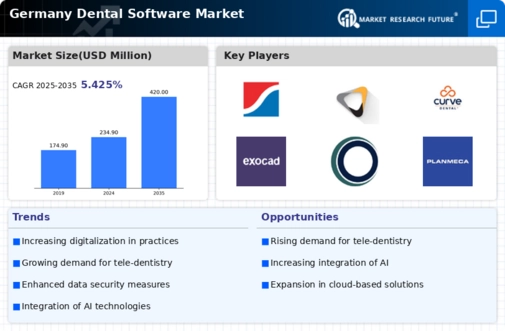The Germany Dental Software Market is characterized by a dynamic competitive landscape fueled by advancements in technology and increasing demand for efficient dental management systems. This market encompasses a variety of software solutions aimed at enhancing dental practices through improved patient management, treatment planning, imaging, and overall operational efficiency. Various companies are vying for market share, each offering unique features and functionalities tailored to meet the specific needs of dental professionals across the country.
The competition within this sector encourages continual innovation, resulting in heightened service offerings that not only streamline practices but also significantly enhance patient care experiences. Companies within this domain are increasingly focusing on integrating cloud-based solutions and advanced digital tools to cater to evolving market demands and preferences. 3Shape holds a strong position in the Germany Dental Software Market, renowned for its innovative solutions that cater to dental practices and laboratories.
The company is particularly recognized for its powerful scanning technology and CAD/CAM software that facilitate efficient dental workflows. Its products are designed to improve accuracy in dental procedures while also allowing dental professionals to effectively manage patient information and treatment plans. 3Shape’s commitment to enhancing user experience has been evident through dedicated customer support and frequent software updates, positioning it as a trusted partner for dental practices in Germany.
The brand's strong presence and reputation have been reinforced by its ability to adapt to the local market needs while maintaining a focus on technological advancements that support improved patient care and practice efficiency. Henry Schein has established a significant foothold in the Germany Dental Software Market, steadily expanding its offerings to meet the diverse needs of dental professionals. Known for its comprehensive suite of products, Henry Schein provides a range of software solutions that include practice management systems, digital imaging, and patient engagement tools.
The company’s extensive distribution network and robust customer service infrastructure contribute to its competitive strength, allowing it to reach a broad customer base effectively. Additionally, Henry Schein has pursued strategic mergers and acquisitions to enhance its product portfolio and bolster its position in Germany, enabling it to provide integrated solutions that streamline dental practices. Its strengths lie in its comprehensive understanding of market dynamics, feedback-led product improvements, and adherence to regulatory standards that enhance its credibility and relevance within the German dental sector.




















Leave a Comment